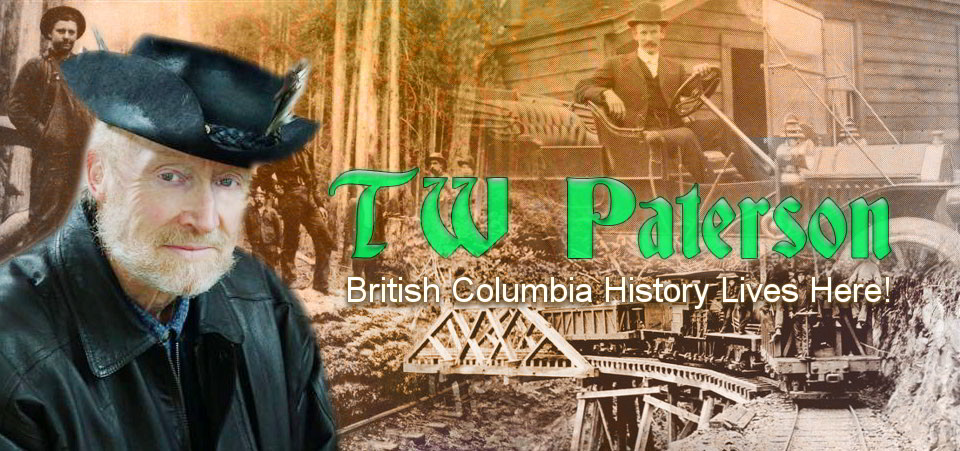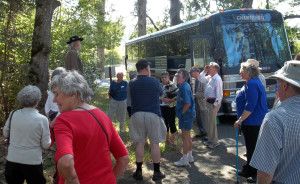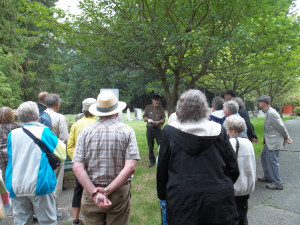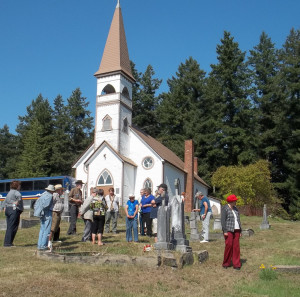Old Cemetery Society Visits Cowichan Valley Cemeteries
I thought I knew my Cowichan Valley cemeteries. I do, of course, but, oh, what a difference a year makes!
A year ago, I could take you to almost any grave I’d mentioned in Tales the Tombstones Tell, my ‘walking guidebook’ to Cowichan’s 16 public cemeteries. That’s because everything was fresh in my mind, as indeed it should have been after 30 years’ research and scores of trips, for weeks on end, to each one in search of stories and to take photos.
But leading last week’s bus tour for Victoria’s Old Cemetery Society proved to be more challenging, more time-consuming and more work than I expected.
Probably because, when you think of it, while there aren’t that many cemeteries in the Cowichan Valley, there are thousands of graves, all of them randomly placed without a thought given to a storyteller’s needs.
Which graves to choose?
My first problem was to select my cemeteries as 16, obviously, would require more than a six-hour tour less pit-stops, lunch, the unforeseen and travel time between. So it became eight cemeteries on a north-south axis, beginning at our meeting place, Mill Bay Shopping Centre.
First up was Mill Bay Methodist/United Church which dates back to 1897 and whose residents’ names read like a Cowichan Valley road map: Hollings, McLay, Chapman, Garnett, Cavin. The headliner, if I may put it so crudely, is Francis Walker, whose death–crushed between two massive logs–was nothing less than heroic, so calmly did he instruct his helper in hitching oxen to the logs to separate them and to free him. Conscious throughout, he had to have known that he was grievously, if not mortally, injured.
Men were men in those days; the women, too
Francis Garnett’s internal injuries were indeed fatal, hence his premature placement in the tiny Mill Bay Methodist/United cemetery beside the busy Island Highway at Mill Bay.
Immediately to the north on Church Road is the postcard-picturesque Catholic church St. Francis Xavier which celebrated its 125th anniversary in September 2012. Remarkably, it wasn’t dedicated until 1969. Among the pioneers resting here are the Deloume family, beginning with the grandmother who originally was interred in Victoria’s ocean-side Ross Bay Cemetery.
But when wind, tide and erosion threatened to wash her out to sea, the alarmed Deloumes removed her to the little church in the wildwood at Mill Bay. At least it was in the wildwood then; now it’s almost encircled by highway, roads and commercial development.
Then it was across the highway to Cobble Hill’s St. John the Baptist. This Anglican church, as does St. Peter’s, Quamichan, invites visitors to tour its small cemetery. Happily, there’s no sign of vandalism here as is, sad to say, the case elsewhere in the Cowichan Valley.
All three Hook brothers were victims of the First World War
The stars here (I’m speaking as a storyteller, you understand) are the brothers, Duncan, Robin and Geoffrey Hook. The first two, both lieutenants in the Lancashire Fusiliers, died a day apart at Gallipoli, the infamous failed attempt by the British to seize the strategic Dardanelles in the First World War. Geoffrey, RAF, was home on sick leave when he died from “war related complications,” Oct. 4, 1918. The deadly Spanish ‘flu epidemic was then on the rampage, I might add.
Because Cowichan’s most famous and iconic church, the 1870 Old Stone aka the Butter Church is on Cowichan Tribes land at Comiaken, we settled for a drive-by and some exterior photos. It’s heartbreaking to see this beautiful and historic structure being repeatedly and extensively damaged by whom and for reasons unknown.
Poor Father Peter Rondault, its builder who doubled as a farmer and paid his contractor by selling butter, must be turning in his grave.
Which, by the way, is at our next stop, beautiful St. Ann’s, Tzouhalem, a mile or so to the west. There are some beautiful headstones here but many of them have been brutalized. (I’ll never understand the thinking of these cretins.)
Most headstones are teasers–you have to research the story
I didn’t have time to look for my favourite headstone, a simple concrete marker for a boy whose name, given simply as David, is spelled out in marbles. But there are numerous other fascinating graves and stories here. That for Dan Mahony, 24, proves yet again that there’s many a good story if you research the few brief lines on a grave marker.
Young Dan had gone hunting with his shiny new Henry repeating rifle and when he saw something brown moving in the bush he let fly. But instead of a deer, he found friend and neighbour Alfred Sutton, dead. Each man had thought he had the mountain to himself. Dan couldn’t overcome his grief and guilt at killing Sutton, even though everyone, Alfred’s family included, accepted it as a tragic accident. Depressed, Dan withdrew into himself and soon followed Alfred to the grave.
With two other men William Tzouhalem, 1873-1912, risked his life to save passengers from the sinking coastal freighter S.S. Iroquois during a storm off Sidney in April 1911. Just as well that they did, too, as Capt. Sears and his purser, co-owners of the ship, had taken off in the lifeboat leaving men, women and children to their fates. (There’s a story for you! I tell it in detail in Cowichan Chronicles, Volume 3.) For their heroism, William and his companions were awarded government lifesaving medals, and just in time as poor William died shortly afterward of blood poisoning.
‘Massacred by Indians!’ (sic)
Just along Tzouhalem Road is St. Peter’s, Quamichan, where the aforementioned Alfred Sutton and hundreds of other pioneers take their eternal rest. This must be one of the most beautiful cemeteries on the Island. For now, I’ll settle for the common headstone marking the graves of William Henry Dring and Charles Miller who were–it says so, right there, carved in stone–“massacred.” This provocative inscription supposedly warranted notice by Ripley’s Believe It Or Not years ago.
Suffice to say, there are many, many great stories to be told here and I tell many of them in Tales the Tombstones Tell.
Then it was on to Mountain View Cemetery whose old, original section in the southwest corner of this large municipal cemetery is also chock-full of fascinating pioneers. They include the Cowichan Valley’s single provincial premier, William Smithe, who died in office in 1886. My two favourites, if I maybe permitted, are Harry Spinks, the City of Duncan’s 83-year-old street sweeper at the time of his disappearance in 1946, and Mildred Maude Lilley whose body was found under mysterious circumstances on an abandoned homestead in Crofton in 1933.
Harry’s absence prompted a major week-long search
But poor Mildred vanished without even her own family noticing until notified by police that her body had been recovered from a well…
By then it was pushing 4 o’clock when the bus had to head back to Victoria for 5, so we had to forego neighbouring St. Mary’s, Somenos, with its own fascinating tales to tell. Among the best is that of Clara Gravenor who, upon arriving home found one afternoon that her husband was drying sticks of blasting powder and dynamite by laying them about the kitchen stove. Unperturbed, she chose to make tea!
Another tour, another day, perhaps…
(From the November-December 2013 issue of Stone Cuttings, the OCS newsletter, this friendly review by Peggy Magee of our bus tour of Cowichan Valley graveyards…)
If you like scary stories, forget ghosts and goblins and explore Tom Paterson’s true life and true death stories of the Cowichan Valley. To add to the effect, we had fog most of the day of our tour on September 14. Because the Valley is broad with a web of roads to small villages and churches, there is much to learn.
At the time that Victoria was dealing with gold rushes and Nanaimo was deep into coal mining, Cowichan was drawing retired British army officers and immigrants from Europe who were attracted to the farming possibilities. The cemeteries tell of high infant mortality, war casualties, industrial accidents, and stalwart men and women.
Some of the earliest churches were built by sawmill workers, some were not consecrated and did not have ministers for many years, and some congregations outgrew their churches and abandoned the building, but the adjacent cemetery remains.
Babies’ graves remind us of the advances in medicine, but nothing can prepare us for the accidents, such as befell Francis Garnett who was crushed between two “man-sized” logs, but lived long enough to give orders to his helpers to have the ox team pull the logs apart. Francis and his wife, Lizzie, are buried beside the Mill Bay United/Methodist Church. Worrying about graves in Ross Bay Cemetery being washed away, the Deloume family from France moved their matriarch to St. Francis Xavier Catholic Church of Mill Bay.
At the cemetery of St. John the Baptist, Cobble Hill, we found a memorial stone to the three Hook sons, victims of war. Nearby, are buried the Oldhams, parents of Dr. Frances Kelsey, former director of the US Food and Drug Administration, who refused to approve the license for thalidomide, thus saving the country from that calamity.
Knitters will be interested to know that [Jeremina Colvin] is buried at Mountain View Cemetery. An immigrant from the [Shetlands], [Jeremina] taught the local First Nations how to knit and that was the beginning of the Cowichan Sweater craft.
St. Peter’s, Quamichan, with its numerous military officers and spring flowers is the most famous cemetery in the area.
After a picnic-style lunch in [Hecate Park] on Cowichan Bay, a few more cemeteries rounded out another memorable OCS tour.
To find out more, pick up a copy of Tales the Tombstones Tell, T.W. Paterson’s most recent book.




Good day T.W.
Can you tell me anything about any postage stamp club in Duncan BC before the Cowichan Stamp Club formed in 1967?
Or any information on the club that formed in 1967?
Hi, Mary: I’ve passed your query on to my friend Priscilla Lowe, retired curator of the Cowichan Valley Museum and currently a volunteer in the CVM Archives for possible answer. I do know that the late Gerry Wellburn who founded the B.C. Forest Museum (today’s B.C. Forest Discovery Centre) was internationally recognized as a philatelist in the 1940s and ’50s. TW
I am into family heritage in quite a big way, as my family heritage website shows. The Suttons (including Alfred) are distant relatives. The Suttons are an amazing family, beginning with Richard Suttonhttp://janetandstephen.info/foster/richardsutton.html who, it is argued (very strongly) was part role model for Heathcliff in Wuthering Heights. If you scroll down this page you will eventually come to what happened to his descendants. His grandson, another Richard Sutton, emigrated to Canada in 1850, Alfred is his son.
At the same time that Richard went to Canada, his uncle, William Sutton did (not sure if they went together). William became the first sheriff of Brant County before he moved to B.C. see http://janetandstephen.info/foster/williamsutton.html
William’s son, William John Sutton, was a famous geologist and, I believe, there are several places named after him including Sutton Pass: http://janetandstephen.info/foster/williamjohnsutton.html
Another son, James Edward, was very much involved in Wreck Bay gold mining: C:\janetandstephen\foster\jamesedwardsutton.html
Hi: Now this is the kind of comment I love! In fact, you’ve given me several new leads to explore. I’ve written the ‘full’ story about Alfred Sutton’s tragic death in two of my books, ‘Cowichan Chronicles, Vol. 1’ and ‘Tales the Tombstones Tell.’ As I mention, we have Sutton Creek in the Cowichan Lake area. I’ll read your posts as soon as I can. Thanks again for writing. –TWP
I have just written two articles, both for the Sedbergh Historian, a local history journal in North Yorkshire, England. The first one is on William Sutton, the second on his son, William John Sutton. They should be published in the Spring and Summer editions. I have now embarked on a full biography of William John Sutton.
May I ask your interest in the Suttons? Are they relations? I’d love to see copies upon publication if you’d be so kind.I could give you a plug in my column in the Cowichan Valley Citizen.
Do you have photos, by the way? I’m not aware of any at this end although I’ve taken good shots of Alfred’s headstone in St. Peter’s, Quamichan cemetery and Dan Mahoney’s in St. Ann’s, Tzouhalem cemetery. Thank you for writing. –TWP
William Sutton is my third great grand uncle; Alfred is my second cousin, 3 x removed. I have begun to write a biography of William John (William Sutton’s son). I don’t have photos of Alfred’s headstone but have one of William Sutton, his wife, and their children. One thing (of many) that intrigues me, which you might find interesting, concerns the death of Alfred’s parents, although they both died in Bruce County – they both died of stomach cancer, Richard when he was 54 and Isabella when she was 61. One of my chapters will be on Cowichan – concerning the family involvement in timber – Genoa Mill, Sutton Creek (which I believe is named after them), Alfred and local elections as William John stood twice but was not elected. The Suttons were in the Cowichan area from about 1878 to 1890. So I might be in touch again later if that is ok?
By the way, I see you mention a Margaret Sutton on your website somewhere, do I take it this is Alfred’s wife or their daughter or someone completely different?
Thank you for this. I shall respond in greater detail as I can. I’ve written about the Suttons, William Robertson and the Genoa Bay sawmill in Cowichan Chronicles, vol. 1 and my latest book, Tales the Tombstones Tell, which has a colour photo of Alfred Sutton’s headstone at St. Peter’s cemetery. I’ll email you a copy if you so wish. Right now, though, it’s back to my deadline. –TWP
I realise I have a copy of the gravestone which I got from the internet. I’m very interested in your article on the Suttons, William Robertson and Genoa Mill though.
I have just seen that in your first Cowichan Chronicles you have a piece on the Lost silver mine of the Koksilah – would this be the Stirling Mine?
No, the shaft that Bill Irvine found was during the building of the E&N Railway, meaning about 1886, which predates William Robertson’s Stirling Mine. There was a silver mining boom along the upper reaches of the Koksilah River shortly after the turn of the last century and you can still find abandoned shafts although some of these are of a later era when copper was the goal. The King Solomon Mine that gives our famous Kinsol Trestle its name is of this vintage. –TW
Hello, I am desperately looking for family information on Harry Spinks, he would have been my husbands grandfathers uncle. We know he immigrated to Canada, his daughter Florrie was his sponser, and he had two young children. We also know about his tragic death. I am putting together a comprehensive family tree of Harry and his Brother Horatio. The one thing we haven’t got is a photograph of Harry. I wonder if you can help me.
Many thanks
Donna Spinks
Hi, Donna: I’m afraid I can’t help you with a photo of Harry Spinks whose mysterious and tragic death I’ve written about in my book, ‘Tales the Tombstones Tell.’ I do have a photo in my files of his and his wife’s graves in Mountain View Cemetery but that’s it. –TWP
Hello Donna,
I am in Vancouver B.C. and I recently accquired two real photo postcards sent by Florrie Spinks. Both posctcards show members of the Spinks family (from a distance) in front of their Duncan home (c.1914).
One of the postcards notes: “Miss Florrie Spinks wishing you a happy & prosperous New Year from Dad, Ma, Maude, Ted & George”
Hello Mr Paterson , I have been tracking information on my family Tree and have finally reached this site, My info is for you and Jan Bridget. I am a relative of Alfred Sutton, My fathers mother ( deceased )is the daughter of Agate Maude Smithson ( Sutton ) who is the daughter of Alfread Sutton. Daphnie ( my grandmother ) was the first white child born in Geona Bay / Cowichan . With this info it would seem Jan and I are related. I am new to the search but I may be able to fill in some holes regarding my side of the information. I would be happy connect and see if I can offer some information. As well if Jan is still staying in touch a connection would be appreciated.
With aplologies, Michael, but I’ve just come through three months of solid overtime getting my newest book to press and have had to neglect the comments on my website, among other things.
I’ve told the story of Alfred Sutton’s tragic demise, and that of the Genoa Bay sawmill, in various of my books. Please let me get back to you. –TWP
Have only just picked up on this, would you please pass on my email to Michael Ryan, by the way, I couldn’t find a publisher for my book so here it is on line: http://janetandstephen.info/publications.html
This is fascinating stuff! Please let me get back to your about Mr. Sutton. –TW